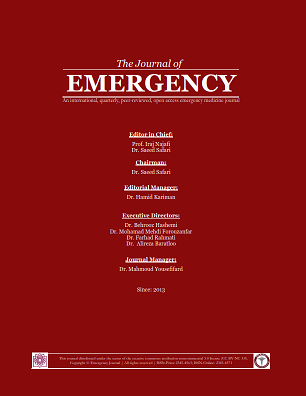Simultaneous Occurrence of Dysrhythmia and Seizure as a Diagnostic Difficulty; a Case Report
EMERGENCY ,
Vol. 6 No. 1 (2018),
19 November 2017
,
Page e49
https://doi.org/10.22037/emergency.v6i1.21749
Abstract
Torsades de pointes (TdP) is a rare but hazardous ventricular dysrhythmia caused by an increase in the QT interval of the heart rhythm and is categorized into congenital or acquired types. Signs and symptoms of TdP include syncope, seizure, ventricular fibrillation, and even sudden death. According to statistics, among these symptoms, syncope and the seizure can be considered as signs that make the TdP diagnosis difficult. Here, we present an infant referring to Vali-e-Asr Hospital in Birjand with frequent seizures and aspiration pneumonia. She was diagnosed with Torsades de Pointes and a medium-sized patent ductus arteriosus, and subsequently underwent a patent ductus arteriosus ligation.
- Torsade de Pointes
- Seizures
- Patent Ductus Arteriosus
- Infant
References
Al-Khatib SM, Stevenson WG, Ackerman MJ, Bryant WJ, Callans DJ, Curtis AB, et al. 2017 AHA/ACC/HRS Guideline for Management of Patients With Ventricular Arrhythmias and the Prevention of Sudden Cardiac Death: A Report of the American College of Cardiology/American Heart Association Task Force on Clinical Practice Guidelines and the Heart Rhythm Society. Journal of the American College of Cardiology. 2017:24390.
Makkar RR, Fromm BS, Steinman RT, Meissner MD, Lehmann MH. Female Gender as a Risk Factor for Torsades de Pointes Associated With Cardiovascular Drugs. JAMA: The Journal of the American Medical Association. 1993;270(21):2590-7.
Roden DM. Drug-Induced Prolongation of the QT Interval. New England Journal of Medicine. 2004;350(10):1013-22.
Salehi F, Taheri MMH, Riasi H, Mehrpour O. Recurrent syncope following substance abuse; a case report. Emergency. 2017;5(1).
Yap YG, Camm J. Risk of torsades de pointes with non-cardiac drugs. British Medical Journal. 2000;320(7243):1158-9.
Gowda RM, Khan IA, Wilbur SL, Vasavada BC, Sacchi TJ. Torsade de pointes: The clinical considerations. International Journal of Cardiology. 2004;96(1):1-6.
Itoh H, Crotti L, Aiba T, Spazzolini C, Denjoy I, Fressart V, et al. The genetics underlying acquired long QT syndrome: Impact for genetic screening. European Heart Journal. 2016;37(18):1456-64.
Kliegman R, Stanton B, St Geme JW, Schor NF, Behrman RE. Nelson textbook of pediatrics Edition 20 ed: Philadelphia, PA : Elsevier, [2016]; 2016.
Lempert T, Bauer M, Schmidt D. Syncope: a videometric analysis of 56 episodes of transient cerebral hypoxia. Annals of neurology. 1994;36(2):233-7.
Baratloo A, Rouhipour A, Forouzanfar M, Rahmati F, Hashemi B. Hypokalemia-induced abnormal movements: case report. Trauma monthly. 2013;18(3):141-4.
Sabu J, Regeti K, Mallappallil M, Kassotis J, Islam H, Zafar S, et al. Convulsive syncope induced by ventricular arrhythmia masquerading as epileptic seizures: case report and literature review. Journal of clinical medicine research. 2016;8(8):610.
Scheepers B, Clough P, Pickles C. The misdiagnosis of epilepsy: findings of a population study. Seizure. 1998;7(5):403-6.
Smith D, Defalla B, Chadwick D. The misdiagnosis of epilepsy and the management of refractory epilepsy in a specialist clinic. Qjm. 1999;92(1):15-23.
Angus-Leppan H. First seizures in adults. BMJ. 2014;348:g2470.
Isbister GK. Risk assessment of drug-induced QT prolongation. Australian prescriber. 2015;38(1):20.
- Abstract Viewed: 500 times
- PDF Downloaded: 393 times
